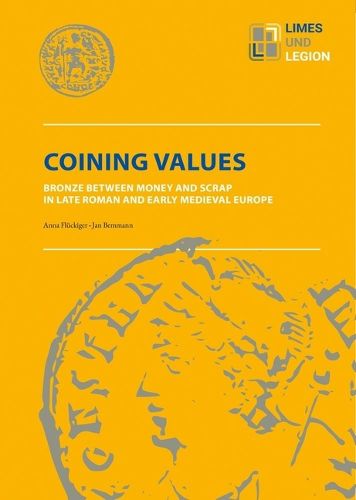Readings Newsletter
Become a Readings Member to make your shopping experience even easier.
Sign in or sign up for free!
You’re not far away from qualifying for FREE standard shipping within Australia
You’ve qualified for FREE standard shipping within Australia
The cart is loading…






Base metal fragments from archaeological sites in the Roman Northwest and adjacent Barbaricum are largely classed as recycling material up until Late Antiquity. At that time, however, coinage experiences a massive change. Bronze coins become increasingly devalued before entirely disappearing from the monetary system during the first half of the 5th century AD. The archaeological record reflects this transformation in a complex, enigmatic manner. Viewed together, the practices surrounding coins and scrap reveal a myriad of questions concerning possible meanings of value and their transformations. In some instances, people tried to melt down bronze coins, in order to recycle them: was this devaluation or valorization? On one hand, some excavations yield carpet-like layers of scattered coins. Were they lostor discarded? On the other, the Theodosian bronze coin hoards must also be taken into account: stashes of value or waste metal rendered useless? On the same note, the question arises whether artefacts were fragmented into weighted unitsas is the case for the well-known (Hack-)silver. If so, for what purpose, and on which chronological, regional and quantitative scale? Did Hackbronze, occasionally or even regularly, hold para-monetary functions equal to small ingots? The volume contains the papers presented at an international conference held in Bonn on October 2628, 2023. The conference provided an opportunity to examine how to reconstruct transformations in practice such as the above toward coins and base metal artefacts, thus assessing the significance of bronze within material culture. It was possible to approach not only the extent of monetization, but also rarely-identified materialand immaterial values and meanings which in turn can be linked to the material practice as well as the created artefacts. The conference offered space for an international forum at the intersection of both Roman (Provincial) and early Historic archaeology, and Numismatics. The issues raised concerned the base metal coins in the archaeological record, their circulation and manners of reuse, phenomena around counterfeits and local imitations, as well as practices regarding copper alloy artefacts: origin and production, transport and trade. Special attention was paid to fragmentation, reuse, deposition and loss. Supraregional trends were observed as well as small-scale occurrences.
$9.00 standard shipping within Australia
FREE standard shipping within Australia for orders over $100.00
Express & International shipping calculated at checkout
Stock availability can be subject to change without notice. We recommend calling the shop or contacting our online team to check availability of low stock items. Please see our Shopping Online page for more details.
Base metal fragments from archaeological sites in the Roman Northwest and adjacent Barbaricum are largely classed as recycling material up until Late Antiquity. At that time, however, coinage experiences a massive change. Bronze coins become increasingly devalued before entirely disappearing from the monetary system during the first half of the 5th century AD. The archaeological record reflects this transformation in a complex, enigmatic manner. Viewed together, the practices surrounding coins and scrap reveal a myriad of questions concerning possible meanings of value and their transformations. In some instances, people tried to melt down bronze coins, in order to recycle them: was this devaluation or valorization? On one hand, some excavations yield carpet-like layers of scattered coins. Were they lostor discarded? On the other, the Theodosian bronze coin hoards must also be taken into account: stashes of value or waste metal rendered useless? On the same note, the question arises whether artefacts were fragmented into weighted unitsas is the case for the well-known (Hack-)silver. If so, for what purpose, and on which chronological, regional and quantitative scale? Did Hackbronze, occasionally or even regularly, hold para-monetary functions equal to small ingots? The volume contains the papers presented at an international conference held in Bonn on October 2628, 2023. The conference provided an opportunity to examine how to reconstruct transformations in practice such as the above toward coins and base metal artefacts, thus assessing the significance of bronze within material culture. It was possible to approach not only the extent of monetization, but also rarely-identified materialand immaterial values and meanings which in turn can be linked to the material practice as well as the created artefacts. The conference offered space for an international forum at the intersection of both Roman (Provincial) and early Historic archaeology, and Numismatics. The issues raised concerned the base metal coins in the archaeological record, their circulation and manners of reuse, phenomena around counterfeits and local imitations, as well as practices regarding copper alloy artefacts: origin and production, transport and trade. Special attention was paid to fragmentation, reuse, deposition and loss. Supraregional trends were observed as well as small-scale occurrences.